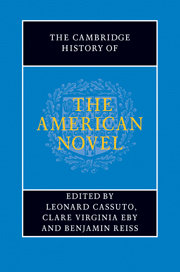Book contents
- Frontmatter
- General Introduction
- PART ONE INVENTING THE AMERICAN NOVEL
- PART TWO REALISM, PROTEST, ACCOMMODATION
- Introduction: realism, protest, accommodation
- 17 Realism and radicalism: the school of Howells
- 18 James, pragmatism, and the realist ideal
- 19 Theories of the American novel in the age of realism
- 20 The novel in postbellum print culture
- 21 Twain, class, and the Gilded Age
- 22 Dreiser and the city
- 23 Novels of civic protest
- 24 Novels of American business, industry, and consumerism
- 25 New Americans and the immigrant novel
- 26 Cather and the regional imagination
- 27 Wharton, marriage, and the New Woman
- 28 The postbellum race novel
- 29 The African American novel after Reconstruction
- 30 The rise of naturalism
- 31 Imagining the frontier
- 32 Imperialism, Orientalism, and empire
- 33 The hemispheric novel in the post-revolutionary era
- 34 The woman's novel beyond sentimentalism
- 35 Dime novels and the rise of mass-market genres
- 36 Readers and reading groups
- PART THREE MODERNISM AND BEYOND
- PART FOUR CONTEMPORARY FORMATIONS
- A selected bibliography
- Index
36 - Readers and reading groups
from PART TWO - REALISM, PROTEST, ACCOMMODATION
Published online by Cambridge University Press: 28 July 2011
- Frontmatter
- General Introduction
- PART ONE INVENTING THE AMERICAN NOVEL
- PART TWO REALISM, PROTEST, ACCOMMODATION
- Introduction: realism, protest, accommodation
- 17 Realism and radicalism: the school of Howells
- 18 James, pragmatism, and the realist ideal
- 19 Theories of the American novel in the age of realism
- 20 The novel in postbellum print culture
- 21 Twain, class, and the Gilded Age
- 22 Dreiser and the city
- 23 Novels of civic protest
- 24 Novels of American business, industry, and consumerism
- 25 New Americans and the immigrant novel
- 26 Cather and the regional imagination
- 27 Wharton, marriage, and the New Woman
- 28 The postbellum race novel
- 29 The African American novel after Reconstruction
- 30 The rise of naturalism
- 31 Imagining the frontier
- 32 Imperialism, Orientalism, and empire
- 33 The hemispheric novel in the post-revolutionary era
- 34 The woman's novel beyond sentimentalism
- 35 Dime novels and the rise of mass-market genres
- 36 Readers and reading groups
- PART THREE MODERNISM AND BEYOND
- PART FOUR CONTEMPORARY FORMATIONS
- A selected bibliography
- Index
Summary
In an 1873 “Introduction” to A Library of Famous Fiction, Harriet Beecher Stowe recalled that while she was growing up “novels were considered a dangerous indulgence, and in our youth one of the stock themes for composition-writing was ‘On the disadvantages of novel-reading.’” Stowe's comments and the Library of Famous Fiction itself endorse the novel as a literary form; but the declaration of victory over the lingering resistance to fiction was premature. The “rise” of the novel in the United States was uneven. Until well into the twentieth century fiction-reading was an extremely popular but still contested social practice – entertaining, useful, and important for some, disturbing and potentially dangerous for others. The modern novel, Thomas Wentworth Higginson wrote in 1896, “is to this generation what drama was to the Elizabethan age; we must simply accept it as the now recognized mould, into which the brightest contemporary intellect is cast.” A certain reluctance, evident in Higginson's “we must simply accept it,” is often salient in commentaries of the period. Anxiety about fiction-reading as destructive and addictive lingered in many quarters.
This chapter addresses changes in the status of fiction between the 1870s and the 1920s by examining its cultural meaning for several discrete reading publics: cultural insiders (authors and literary commentators; ducators and newly professionalized librarians) but also cultural outsiders (African Americans, immigrants, and children).
- Type
- Chapter
- Information
- The Cambridge History of the American Novel , pp. 600 - 614Publisher: Cambridge University PressPrint publication year: 2011



